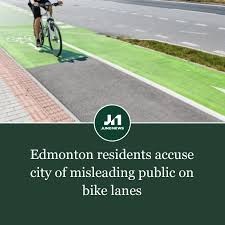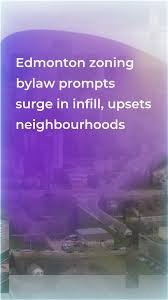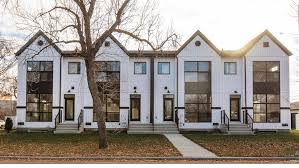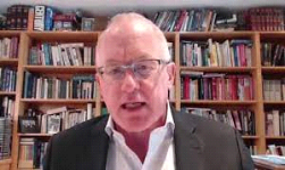City Building Newsletter
The projects bringing The City Plan's vision to life
Infill - Staying Informed about Infill in Your Neighbourhood
The City understands that Edmontonians have questions and concerns about infill in their neighbourhood, and construction taking place near where you live can be unsettling. Check out our information sheet about infill in your neighbourhood so you can know what to expect, how to stay informed about infill, including notifications, and how to report construction complaints. You can also visit edmonton.ca/Infill to learn more and download the information sheet.
While most impacts of construction are temporary and considered typical, residents may still have concerns. We encourage you to contact the builder first, as they may be able to resolve your concern quickly. Following that, if further resolution is needed, use the 311 app, submit a 311 ticket online using the construction site concerns request form or call 311. These are the best ways to make sure your complaint is tracked and acted on as quickly as possible.
Infill plays an important role in helping us respond to population growth and meet the diverse housing needs of both current and future residents. The Zoning Bylaw enables more housing types across the city, giving Edmontonians more choices to live in the neighbourhoods they love.
Downtown - Valley Line West LRT: 102 Avenue bike lane temporary relocation
Upcoming Valley Line West LRT construction in downtown will require the temporary relocation of the 102 Avenue bike lanes to 103 Avenue.
This fall, the City and Marigold Infrastructure Partners (MIP) will install protected bike lanes along 103 Avenue from 103 Street to Rail Town Park, west of 109 Street. The relocated bike lanes will connect to the existing bike network and include wayfinding signage, bike signals, medians and pavement markings. To connect to the 103 Avenue bike lanes, cyclists will be able to use the existing north-south bike infrastructure along Rail Town Park Trail, 106 Street and 103 Street.
The City and MIP appreciate the patience of cyclists and others who will have to adapt their routines. The 103 Avenue bike lanes are expected to be in place until the end of 2027.
To receive updates on construction and the Valley Line project, sign up for MIP’s construction notices or the City’s newsletter.
Pedway - UID program gets help where you need it
Next time you’re in a downtown pedway, check out the Pedway Unique Identifier signs. These signs provide you with a specific number for the pedway you’re using in case you need help from emergency services.
If you have to call 911, give the operator the pedway number, and first responders will know exactly where to find you.

Residents of Alberta Avenue are the latest to voice their objections to bike lanes in their area. Bike lanes and infill housing issues are two hot potatoes the current council has on their hands. Some who are running as candidates for council in October's election are have included bike lanes and infill housing as part of their platform.
Below are 2 recent posts (from NEXTDOOR) which exemplify proposals for two neighbourhoods largely due to infill and rezoning changes.
Lorne Gunter has a suggestion for the city counsellors and developers who support the current infill bylaw. His suggestion is that city counsellors and developers in favor of infill allow eight-plexes to be built on either side of their home before they issue any further permits for the same elsewhere. In other words city counsellors and developers should change NIMBY (Not In My BackYard) to IMBY (In My BackYard)
Lorne Gunter has been a strong voice of common sense regarding the infill bylaw and has written about the issue numerous times before today.
ANALYSIS: WHY THOSE ORGANIZING TO CURB INFILL SAY SIZE, PACE, AND ENGAGEMENT ARE TOP CONCERNS
Stephanie Swensrude
Those organizing to stop, slow, or change infill told Taproot they want new housing in mature neighbourhoods to be smaller, the pace of developments to calm, and for neighbours to have more say in what gets built in their communities.
As part of our ongoing coverage of this year’s municipal election, Taproot is working to explain issues that are dominating election discussions. Infill has taken up a lot of airtime in recent months. Some have said they are angry or sad to see infill housing change their neighbourhoods, while others have urged city council to continue to allow more homes to be built in the city’s core to address climate change and a shortage of housing. Others land somewhere between these positions, supporting infill but being frustrated with how it is being built.
The new zoning bylaw, which made it easier to build infill, went into effect on Jan. 1, 2024. In the bylaw’s first year, the city approved more than 16,500 new dwelling units, a 30% increase compared to 2023. The proportion of housing units approved in the redeveloping area, the part of the city generally within the boundaries of Anthony Henday Drive, increased. In 2024, 40% of approved housing units were located in the redeveloping area. The city’s goal is to add 50% of new housing units through infill in developing areas.
In June, after about 18 months of tracking how the bylaw has changed development in Edmonton, council debated several amendments to it that councillors proposed. The proposed amendments included decreasing the maximum number of units allowed on mid-block lots in the small-scale residential (RS) zone from eight to six and altering the design requirements for rowhouses to make them smaller and have fewer entrances facing neighbouring homes. Council voted to keep the unit maximum the same, but approved the design changes. Coun. Tim Cartmell, who is also running for mayor, introduced a motion calling for a moratorium on development approvals for mid-block properties in the RS zone, which would have been illegal. The motion was ruled out of order.
Taproot spoke with representatives from two groups that voice concerns with infill — Edmonton Neighbourhoods United and the Residential Infill Working Group — to ask what they believe is wrong with Edmonton’s approach and what should be done to fix it.
Public engagement
Both groups said residents were not properly engaged or notified of changes coming to their neighbourhoods.
“With something as big as this new zoning bylaw, there should have been a referendum to engage more people before they just rolled this out,” Dallas Moravec, the treasurer for Edmonton Neighbourhoods United and a resident of Mill Woods, said. “Now they’re trying to do the public engagement piece that they should have done prior to bringing this new zoning bylaw.”
The city engaged residents on the new zoning bylaw starting in 2018. It also engaged residents on the City Plan, which helped shape the zoning bylaw. Council approved the City Plan in 2020.
Jan Hardstaff, a Parkallen resident who spoke on behalf of the Residential Infill Working Group, said that because some of the public engagement for the zoning bylaw took place during the COVID-19 pandemic lockdown, it was not as effective as the workshops and other engagement opportunities the city held in the past. “You’d come together, there’d be industry people there, there’d be community people there, and residents and councillors would come, and we’d all sit in a big room, and we’d go from table to table and talk about different things,” Hardstaff said. “It was interactive and it was collaborative, but this wasn’t like that.”
Moravec said Edmonton Neighbourhoods United is calling for the former version of the zoning bylaw to be reinstated, as that bylaw wasn’t “broken” and made it easier for neighbours to make appeals against new builds. Moravec also suggested that wards should be divided into quadrants, and those communities should meet to discuss where infill would be best suited. The city did something similar in 2024 with the priority growth area rezoning project, when residents were able to point to specific lots on a map that they thought would be ideal for increased density. The city collected that input, and after Garneau residents asked for some properties to be removed from the project, the city obliged. Moravec said this was a good example of administration listening to residents.
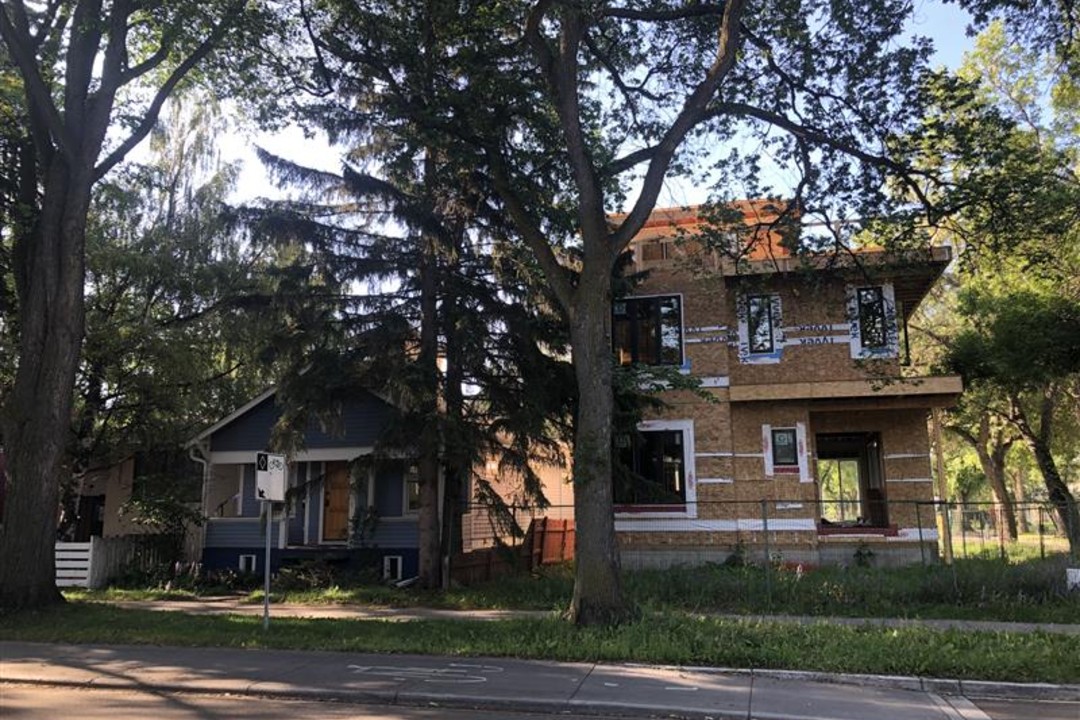 A single-detached infill house in the Strathcona neighbourhood. (Stephanie Swensrude)
A single-detached infill house in the Strathcona neighbourhood. (Stephanie Swensrude)
At June’s public hearing, some residents aired concerns about the zoning bylaw, and the city later made further changes that aligned with some of the feedback. Administration said in its original one-year review of the zoning bylaw that it did not recommend changing the unit maximum in the RS zone. When that report was presented at a council committee meeting on June 3, residents attended to advocate for the maximum to be lowered. At the June 30 public hearing, administration had changed its position and endorsed lowering the unit maximum. The city also considered design recommendations from the Residential Infill Working Group when creating amendments to the bylaw.
But there are limits to how much the city can scribble around the edges to balance the rights of property owners to build on their lots with the concerns of their neighbours. Under the Municipal Government Act, the provincial legislation that governs municipalities, cities are legally required to approve a rezoning application or issue a development permit if the application complies with the land use bylaw. In other words, even if council agreed that it would be unfortunate for the property’s neighbour to lose sunlight access, without a legal reason to deny the application council must approve it (there is no legal right to sunlight access in Alberta).
‘Monolithic’ infill is too big
Hardstaff said she is not against infill. Instead, she said she wants neighbours to be more accepting of infill in their communities, but that such acceptance won’t happen if the developments are “monolithic” buildings that don’t fit into the neighbourhood and lead to trees being cut down.
She said a fellow advocate purchased a home in a mature neighbourhood and now has an eight-plex on either side of his property. “That’s devastating, and it shouldn’t happen,” Hardstaff said. “They put effort and blood, sweat, and tears into doing the renovation and hoping that this would be a place that they would raise their kids and welcome new infill and people who wanted to move into the neighborhood in, say, a semi-detached (house) or secondary suites and backyard suites. Who would have thought that you would get eight-plexes built on either side?”
Hardstaff also cited a University of Alberta study, which found that lots in McKernan and Westmount typically lost about 50% of their tree canopy coverage if an infill development was built on them. Hardstaff said this not only impacts neighbours but the people who live in the infill development, as they don’t have trees to enjoy in their yard.
Development intensity has ‘backs against the wall’
Moravec said the pace of infill development has moved faster than anyone expected. The city needs to issue about 7,500 building permits for missing middle housing units between 2023 and 2026 to be eligible for the federal government’s Housing Accelerator Fund. At the end of 2024, the city had already reached 97% of that goal. ”(The city is) moving really, really quickly and, and that’s what’s got everybody with their backs up against the wall and saying, ’Hey, what’s going on here?”
Hardstaff agrees. She thinks that the people living in the new developments will suffer, too. ”(The city was) so focused on building infill to increase density that they’ve kind of forgotten everyone else, not just the neighbours, but who they’re building that density for,” she said. “I want the people who live in these homes to have quality of life, have affordable housing, and be able to adjust and find new housing as they move through their lives and their circumstances change.”
Both Hardstaff and Moravec said that as infill development gets more attention, more people will be empowered to voice their concerns. “This shows that people, now that they’ve been awakened, they’re quite interested — they’re reading, wanting to be engaged, and unfortunately, though, there’s been a huge impact to public trust,” Hardstaff said. “They’re not going to be so easily dismissed.”
As for the criticism that people speaking out about infill are NIMBYs, some said they don’t mind that characterization.
“A NIMBY is really someone who’s just passionate about where they live, and so I don’t think it’s actually a bad thing,” Moravec said. “Sure, call me a NIMBY because I do care about what happens in my community, and if that’s how you want to just label me, by all means.”
Broader infill opposition
As the municipal election on Oct. 20 approaches, Edmonton Neighbourhoods United and the Residential Infill Working Group are just two of the groups organizing to oppose infill, or how it is being built, in Edmonton. There’s also SaveYEG and the Coalition for Better Infill, and dozens of people who regularly attend meetings where council discusses infill development.
Many Edmonton residents have asked who funds these groups.
Hardstaff said the Residential Infill Working Group receives no funding and is run by volunteers. Moravec, meanwhile, first said he preferred not to answer, but then added: “I guess the best way to answer that without revealing too much of our hand, because we’re just getting going and we’re grassroots, but it’s been all donations.”
Correction: This story has been updated to correct Jan Hardstaff’s neighbourhood.
Lorne Gunter opined publicly what many think privately about how to solve the infill problem created under the current city council's watch - vote out the whole council and start anew with some fresh faces and ideas.


